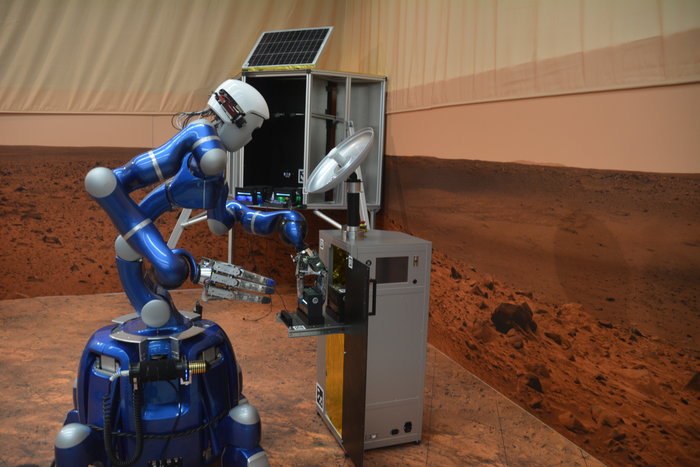European Space Agency (ESA) Astronaut Alexander Gerst is currently on the International Space Station (ISS), flying 400 km (249 miles) above Earth at a whopping 28,800 km/h (17,895 mph). Although he’s space-bound at the moment, he managed to take an Earthly stroll Friday, August 17, 2018.
How was this possible? He visited Earth with the help of machines, as he directed a humanoid robot named Rollin’ Justin, located in Oberpfaffenhofen, Germany, at the DLR German Aerospace Center.
This astronaut-robot pairing was the latest experiment added to the Multi-Purpose End-to-End Robotic Operations Network (METERON) project. According to NASA, the project “examines the benefits of controlling surface robots in real time from an orbiting spacecraft,” which can keep humans safe when exploring the potentially hazardous environments of other planets.
“DLR’s Rollin’ Justin possesses a high level of autonomy. For Alexander it will be more like supervising Justin than performing direct remote control,” says ESA’s Thomas Krueger from the Agency’s Human Robot Interaction Lab.
During the experiment, Gerst used a tablet to see through the robot’s point of view. Using this technique, Gerst could visually identify which objects needed the robot’s focus among a set of solar panels. The two-hour test took place in a simulated Martian environment.
“Rather than commanding every joint and every movement of the robot, which demands a high mental workload from the human, we rely on the robot’s intelligence to carry out small task packages as commanded by the ISS crew,” says the experiment’s Principal Investigator Neal Lii of DLR, via the ESA. “What we’re looking for with these SUPVIS Justin experiments is demonstrate robots as genuine co-workers, where astronauts give abstract commands that the robots can compute locally then carry out. Our model is supervised autonomy, with astronauts able to manage a team of robots to achieve a given goal.”
“We want to see how we can make the interaction as easy and intuitive as possible, while building up the complexity of the tasks with each successive ISS-ground experiment. Starting with simpler switching on/off tasks, we have advanced to asset retrieval, installation, and dexterous repairs for this session. These represent some of the most dexterous telerobotic tasks to be commanded from space to date,” Lii adds.
Rollin’ Justin was publically introduced back in 2008. The semi-autonomous robot has a number of features, including joint torque sensors, two balance sensors (IMU), hierarchical whole-body control, four RGB-D cameras, and two stereo cameras.
The arms, hands, neck, torso, and platform have a combined 51 degrees of freedom, and it can carry all this tech at a speed of 7.2 km/h (4.5 mph).
You can catch a glimpse of Rollin’ Justin in the photo below.

(Image Credit: DLR, via ESA)
Filed Under: Aerospace + defense, Robotics • robotic grippers • end effectors




